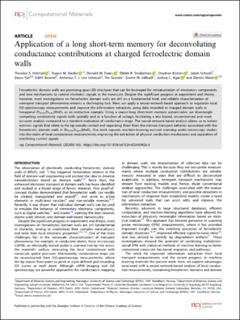| dc.contributor.author | Holstad, Theodor Secanell | |
| dc.contributor.author | Ræder, Trygve Magnus | |
| dc.contributor.author | Evans, Donald | |
| dc.contributor.author | Småbråten, Didrik Rene | |
| dc.contributor.author | Krohns, Stephan | |
| dc.contributor.author | Schaab, Jakob | |
| dc.contributor.author | Yan, Zewu | |
| dc.contributor.author | Bourret, Edith | |
| dc.contributor.author | Helvoort, Antonius T. J. van | |
| dc.contributor.author | Grande, Tor | |
| dc.contributor.author | Selbach, Sverre Magnus | |
| dc.contributor.author | Agar, Joshua | |
| dc.contributor.author | Meier, Dennis Gerhard | |
| dc.date.accessioned | 2021-01-08T08:46:36Z | |
| dc.date.available | 2021-01-08T08:46:36Z | |
| dc.date.created | 2020-12-01T15:15:03Z | |
| dc.date.issued | 2020 | |
| dc.identifier.issn | 2057-3960 | |
| dc.identifier.uri | https://hdl.handle.net/11250/2722134 | |
| dc.description.abstract | Ferroelectric domain walls are promising quasi-2D structures that can be leveraged for miniaturization of electronics components and new mechanisms to control electronic signals at the nanoscale. Despite the significant progress in experiment and theory, however, most investigations on ferroelectric domain walls are still on a fundamental level, and reliable characterization of emergent transport phenomena remains a challenging task. Here, we apply a neural-network-based approach to regularize local I(V)-spectroscopy measurements and improve the information extraction, using data recorded at charged domain walls in hexagonal (Er0.99,Zr0.01)MnO3 as an instructive example. Using a sparse long short-term memory autoencoder, we disentangle competing conductivity signals both spatially and as a function of voltage, facilitating a less biased, unconstrained and more accurate analysis compared to a standard evaluation of conductance maps. The neural-network-based analysis allows us to isolate extrinsic signals that relate to the tip-sample contact and separating them from the intrinsic transport behavior associated with the ferroelectric domain walls in (Er0.99,Zr0.01)MnO3. Our work expands machine-learning-assisted scanning probe microscopy studies into the realm of local conductance measurements, improving the extraction of physical conduction mechanisms and separation of interfering current signals. | en_US |
| dc.language.iso | eng | en_US |
| dc.publisher | Nature | en_US |
| dc.rights | Navngivelse 4.0 Internasjonal | * |
| dc.rights.uri | http://creativecommons.org/licenses/by/4.0/deed.no | * |
| dc.title | Application of a long short-term memory for deconvoluting conductance contributions at charged ferroelectric domain walls | en_US |
| dc.type | Peer reviewed | en_US |
| dc.type | Journal article | en_US |
| dc.description.version | publishedVersion | en_US |
| dc.source.journal | npj Computational Materials | en_US |
| dc.identifier.doi | 10.1038/s41524-020-00426-z | |
| dc.identifier.cristin | 1854914 | |
| dc.description.localcode | Open Access This article is licensed under a Creative Commons Attribution 4.0 International License, which permits use, sharing, adaptation, distribution and reproduction in any medium or format, as long as you give appropriate credit to the original author(s) and the source, provide a link to the Creative Commons license, and indicate if changes were made. The images or other third party material in this article are included in the article’s Creative Commons license, unless indicated otherwise in a credit line to the material. If material is not included in the article’s Creative Commons license and your intended use is not permitted by statutory regulation or exceeds the permitted use, you will need to obtain permission directly from the copyright holder. To view a copy of this license, visit http://creativecommons.org/licenses/by/4.0/. | en_US |
| cristin.ispublished | true | |
| cristin.fulltext | original | |
| cristin.qualitycode | 1 | |

